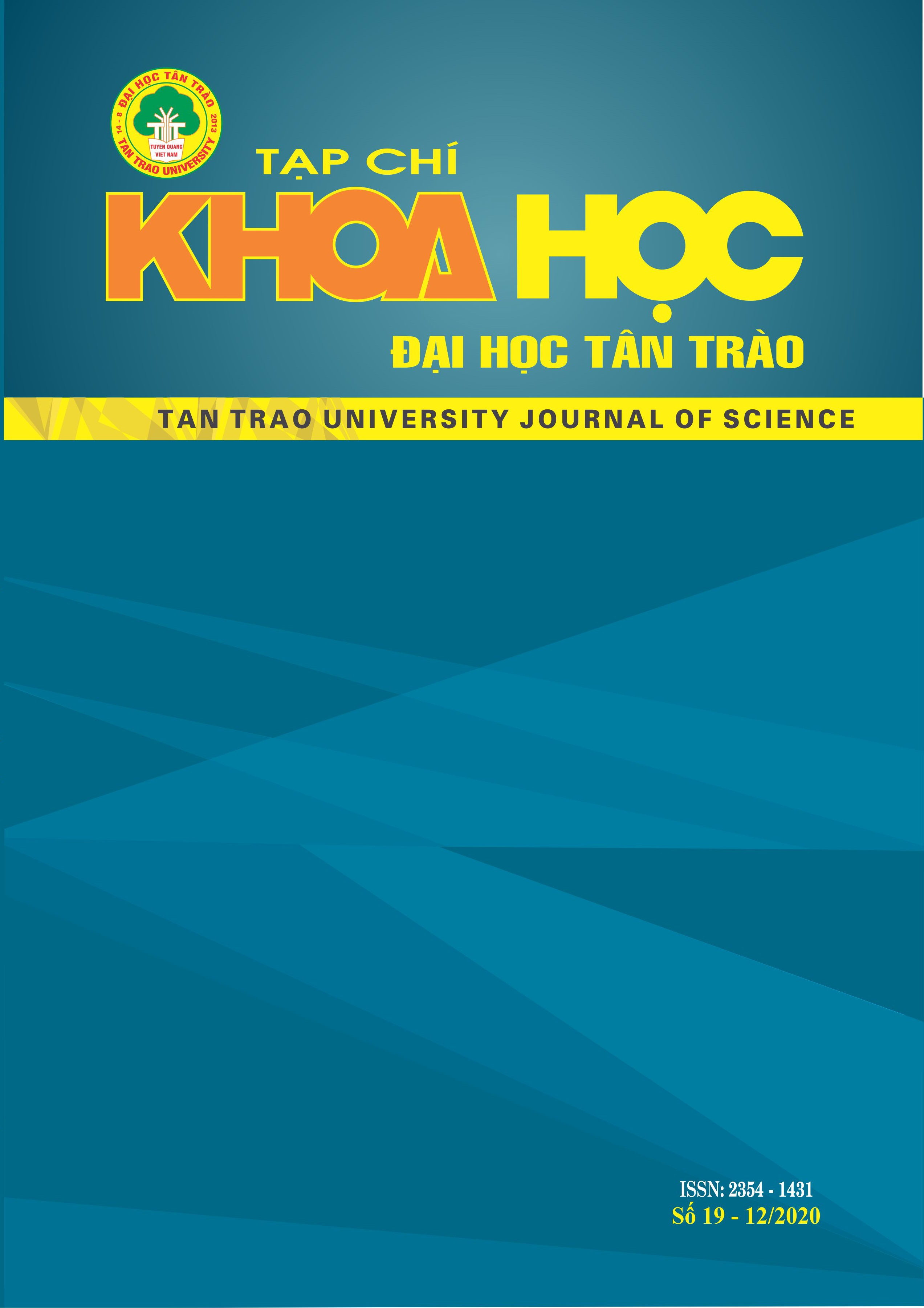Tính toán các tham số thế Morse dưới ảnh hưởng của nhiệt độ và áp suất trong phổ cấu trúc tinh tế hấp thụ tia X mở rộng
DOI:
https://doi.org/10.51453/2354-1431/2020/421Tóm tắt
Một phương pháp mới để ước tính các tham số hiệu dụng của thế Morse dưới ảnh hưởng của rối loạn nhiệt và áp suất đối với các vật liệu có cấu trúc tinh thể được phát triển bằng cách sử dụng năng lượng thăng hoa, khả năng nén và hằng số mạng. Sử dụng các tham số thế Morse đã nhận được để tính toán độ dịch chuyển tương đối trung bình bình phương, hằng số đàn hồi, thế hiệu dụng phi điều hòa và hằng số lực đối với tinh thể bán dẫn silicic và germani, là những vật liệu có cấu trúc tinh thể kim cương. Các kết quả nhận được phù hợp với các kết quả của thực nghiệm và các lý thuyết khác.
Tải xuống
Tài liệu tham khảo
1. E. C. Marques, D. R.Sandrom, F. W. Lytle, and R. B. Greegor, J. Chem (1982). Determination of thermal amplitude of surface atoms in a supported Pt catalyst by EXAFS spectroscopy, Phys. 77, 1027. DOI: https://doi.org/10.1063/1.443914.
2. Duc Nguyen Ba, Binh Nguyen Thanh, Statistical Physics-Theory and Application in XAFS, (LAP LAMBERT, Academic Publishing, 2017), pp 173-198. ISBN: 978-3330041035.
3. N. V. Hung, N. B. Duc, and R. R. Frahm, A New Anharmonic Factor and EXAFS Including Anharmonic Contributions,(2002). J. Phys. Soc. Jpn. 72(5), 1254. DOI: https://doi.org/10.1143/JPSJ.72.1254.
4. Frenkel, A. I., Rehr, J. J. (1993). Thermal expansion and x-ray-absorption fine-structure cumulants. Phys. Rev. B, 48(585). DOI: https://doi.org/10.1103/PhysRevB.48.585.
5. T. Miyanaga and T. Fujikawa, Quantum Statistical Approach to Debye-Waller Factor in EXAFS, EELS and ARXPS. III. Applicability of Debye and Einstein Approximation, (1994). J. Phys. Soc. Jpn. 63 1036, 3683. DOI: https://doi.org/10.1143/JPSJ.63.3683.
6. Hung, N. V., Rehr, J. J. (1997). Phys., Anharmonic correlated Einstein-model Debye-Waller factors. Rev. B 56, 43. DOI: https://doi.org/10.1103/PhysRevB.56.43.
7. T. Miyanaga, H. Katsumata, T. Fujikawa, and T. Ohta, (1997). Ab Initio Calculations of EXAFS Debye-Waller Factors for Two- and Three-Dimensional Crystals. J. de Physique. IV, C2: 225. DOI: https://doi.org/10.1051/jp4/1997173.
8. L. A. Girifalco and V. G. Weizer (1959). Application of the Morse Potential Function to Cubic Metals. Phys. Rev. 114, 687. DOI: https://doi.org/10.1103/PhysRev.114.687.
9. Pirog, I. V., Nedoseikina, T. I., Zarubin, A. I., Shuvaev, A. T. (2002). Anharmonic pair potential study in face-centred-cubic structure metals. J. Phys.: Condens. Matter 14, 1825. DOI: https://doi.org/10.1088/0953-8984/14/8/311.
10. J. C. Slater (1939). Introduction to Chemical Physics, McGraw - Hill Book Company, Inc., New York.
11. Handbook of Physical Constants, Sydney P. Clark, Jr., (1996) Geological Society of America. ISBN print: 9780813710976. DOI: https://doi.org/10.1130/MEM97-p1.
12. Charles Kittel, Introduction to Solid-State Physics, (1986), John Wiley & Sons ed., Inc. New York, Chichester, Brisbane, Toronto, Singapore. ISBN: 978-0-471-41526-8.
13. M. Born, K. Huang (1956). Dynamical Theory of Crystal Lattice, 2nd Ed.,
Oxford: Clarendon Press.
14. P. W. Bridgeman, (1940). The Compression of 46 Substances to 50,000 kg/cm. Proceedings of the American Academy of Arts and Sciences, Vol. 74, No. 3, pp. 21-51. Published by: American Academy of Arts & Sciences, URL: http://www.jstor.org/stable/20023352.
15. R. H. Fowler, E. A. Guggenheim (1939). Statistical Thermodynamics: a version of statistical mechanics for students of physics and chemistry. Cambridge University Press, Cambridge.
16. N. Mott, H. Jones (1936). Properties of Metals and Alloys. Oxford University Press, London.
Tải xuống
Đã Xuất bản
Cách trích dẫn
Số
Chuyên mục
Giấy phép

Tác phẩm này được cấp phép theo Giấy phép Quốc tế Creative Commons Attribution-ShareAlike 4.0 .
Bài báo được xuất bản ở Tạp chí Khoa học Đại học Tân Trào được cấp phép theo giấy phép Ghi công - Chia sẻ tương tự 4.0 Quốc tế (CC BY-SA). Theo đó, các tác giả khác có thể sao chép, chuyển đổi hay phân phối lại các bài báo này với mục đích hợp pháp trên mọi phương tiện, với điều kiện họ trích dẫn tác giả, Tạp chí Khoa học Đại học Tân Trào và đường link đến bản quyền; nêu rõ các thay đổi đã thực hiện và các nghiên cứu đăng lại được tiến hành theo cùng một bản quyền.
Bản quyền bài báo thuộc về các tác giả, không hạn chế số lượng. Tạp chí Khoa học Tân Trào được cấp giấy phép không độc quyền để xuất bản bài báo với tư cách nhà xuất bản nguồn, kèm theo quyền thương mại để in các bài báo cung cấp cho các thư viện và cá nhân.
Mặc dù các điều khoản của giấy phép CC BY-SA không dành cho các tác giả (với tư cách là người giữ bản quyền của bài báo, họ không bị hạn chế về quyền hạn), khi gửi bài tới Tạp chí Khoa học Đại học Tân Trào, tác giả cần đáp ứng quyền của độc giả, và cần cấp quyền cho bên thứ 3 sử dụng bài báo của họ trong phạm vi của giấy phép.


